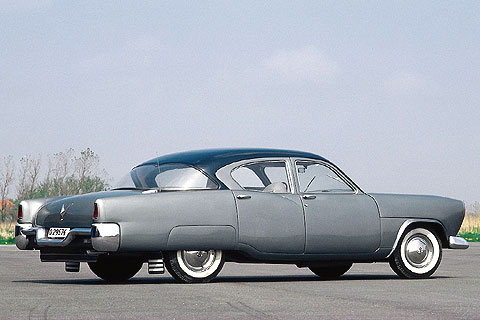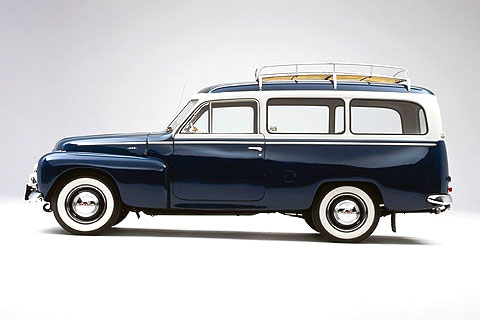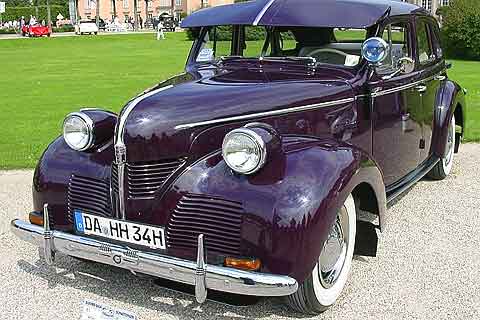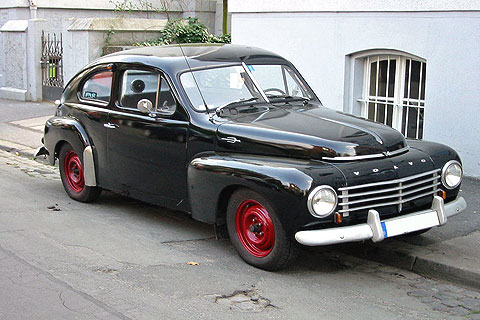In the '50s and '60s , almost every European automakers tried to sell cars in the U.S. Volkswagen, Saab and Volvo are among the few that are still here. The rest disappeared because they were ill suited for American driving conditions or suffered from poor sales and service organizations.
Volvo was one that survived and flourished because their first export, the PV444, worked very well in this country, and proved to be very reliable and durable. These sedans performed and handled as well cars and could carry five in comfort plus lots of luggage. The big reason - the PV444 was designed for the harsh Swedish environment and there was lot of Detroit influence in this early Volvo.
The PV444 was Volvo's first small car. Building its first car, the Jakob, in 1927, previous Volvos were larger cars whose styling and mechanics were inspired by American cars. The PV444 was no exception. The body styling is definitely 1940's Detroit. While the PV444 does bear a resemblance to the 1940 to 1948 Fords, Volvo did not deliberately design a miniature Ford. The resemblance comes about because the PV44 was designed in the 1940s when high waistlines, small back windows, bulging front fenders, and separate rear fenders were in fashion.
 And this isn't a Kaiser, but a 1953 Volvo Philip prototype that never reached production. It even had a V8.1953 Volvo Philip
And this isn't a Kaiser, but a 1953 Volvo Philip prototype that never reached production. It even had a V8.1953 Volvo Philip You see a lot of Detroit influence in the car's mechanics, helping to make Volvos familiar and popular with American drivers. For example, the PV444's front suspension was similar to one used on cars like the Plymouth. The rear suspension was influenced by Oldsmobile designs. The Wagner-Electric brakes were like those used on Studebakers. The rear axle was an American built Spicer. Borg and Beck influenced the clutch design. On early models, a Carter carburetor was installed, as was Autolite electrical equipment. Even the deep drawn steel for the car's body came from the U.S.
The men behind the PV444 also had experience with America cars. Helmer Peterson responsible for the design, had spent six years in Chicago in the 1920s and prior to going to Volvo was a service manager for Swedish GM and Ford dealers. Carl Lindblom, Volvo's chief passenger car engineer, spent the WWII years in the U.S. helping with the war effort. The body structure of the PV444 was designed by a team headed by Edward Lindberg, who had spent ten years in the U.S. industry, including time at Studebaker.
The design of the PV444 started in 1943 in neutral Sweden and it was originally planned for production in 1944, thus the designation PV444. PV stood for Personvagnar. Unveiled to the public in the fall of 1944, it was early 1947 before the first PV444s rolled off the assembly lines because of the lack of materials and components, mainly steel. Waiting for production, the prototypes were subjected to extremely harsh general and road testing. This extended testing gave Volvo much time to detect and correct any bugs before putting cars in the hands of the customer.
The first Volvo PV444s came in black only, with light blue added in 1949. The first cars were powered by a 40 horsepower, four-cylinder engine - the smallest engine ever built by Volvo. Except for a few fours in the early twenties, previous Volvos had six-cylinder engines. Like American cars of the period, the transmission was three-speed with synchromesh only on the second and third gears.
Through the years, the PV444 underwent many running changes. Starting in 1952, more interior and exterior colors were available and there were additional side moldings. In 1955, the split rear window was replaced by a one-piece version. This same year, the taillights were relocated, and in 1956, a redesigned egg crate type grille was used. In 1956, the first of the "performance" Volvos was available to the American public. By adding twin SU carburetors to the B4A it became the B14A "Sport" engine with its twin SU carburetors. Output was 70 horsepower and top speed was in excess of 90 mph. In 1950, the PV445 "Duett" station wagon was added. While the cavernous wagon was most popular, the PV445 was also fitted with truck and van bodies.
 The PV445 Duett.Volvo Duett
The PV445 Duett.Volvo Duett Volvo gave the car a new life in the form of the PV544 that debuted in 1958. Changes included a larger, one-piece convex windshield replacing the two flat panes. The rear window and the taillight assembly were much larger. The interior was also modified quite extensively. For starters, there was an entirely new padded dash with a thermometer type speedometer as well as a new steering wheel. The big news was Volvo's introduction of a three-point seat belt.
When production ceased in October 1965, 440,000 PV444s and PV544s had been produced, of which 160,000 had been exported, mainly to the U.S. Volvo's decision to keep the model in production with the PV 544 was a sound one for some 244,000 PV544s were produced. This is especially significant because it had to compete with the all new, and more modern Amazon, 122S in the U.S., which that came out in 1956.






